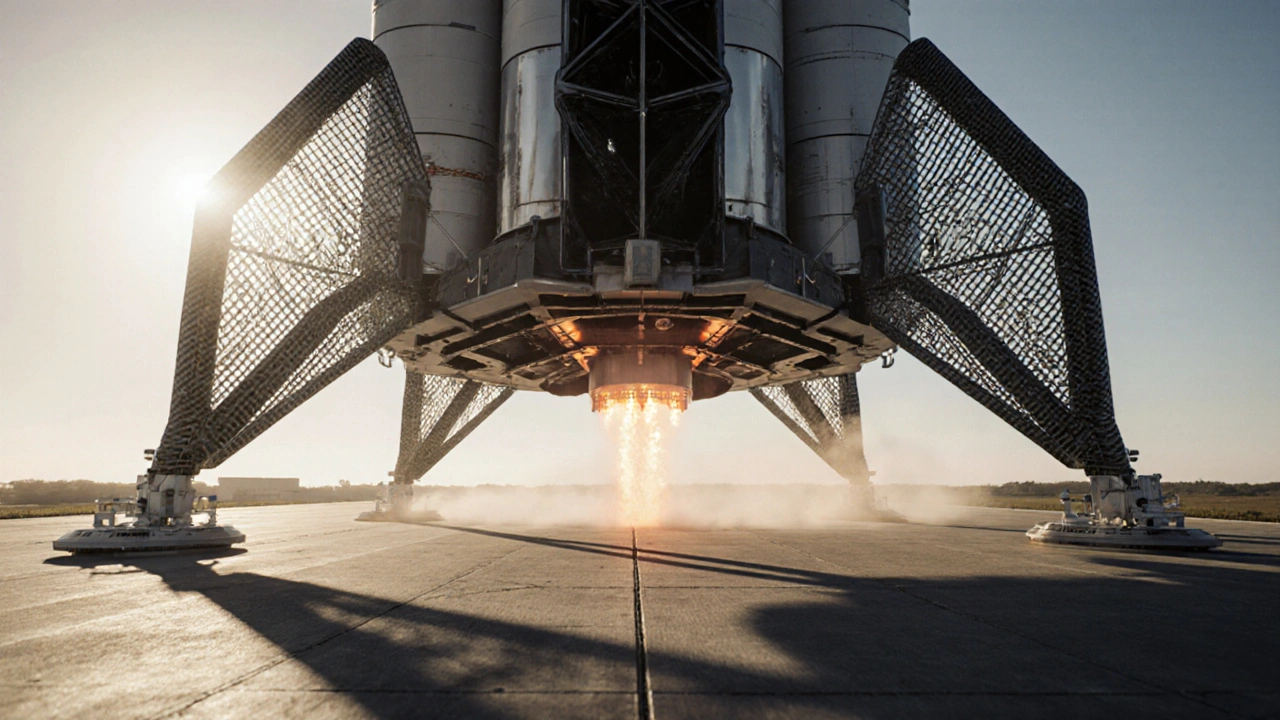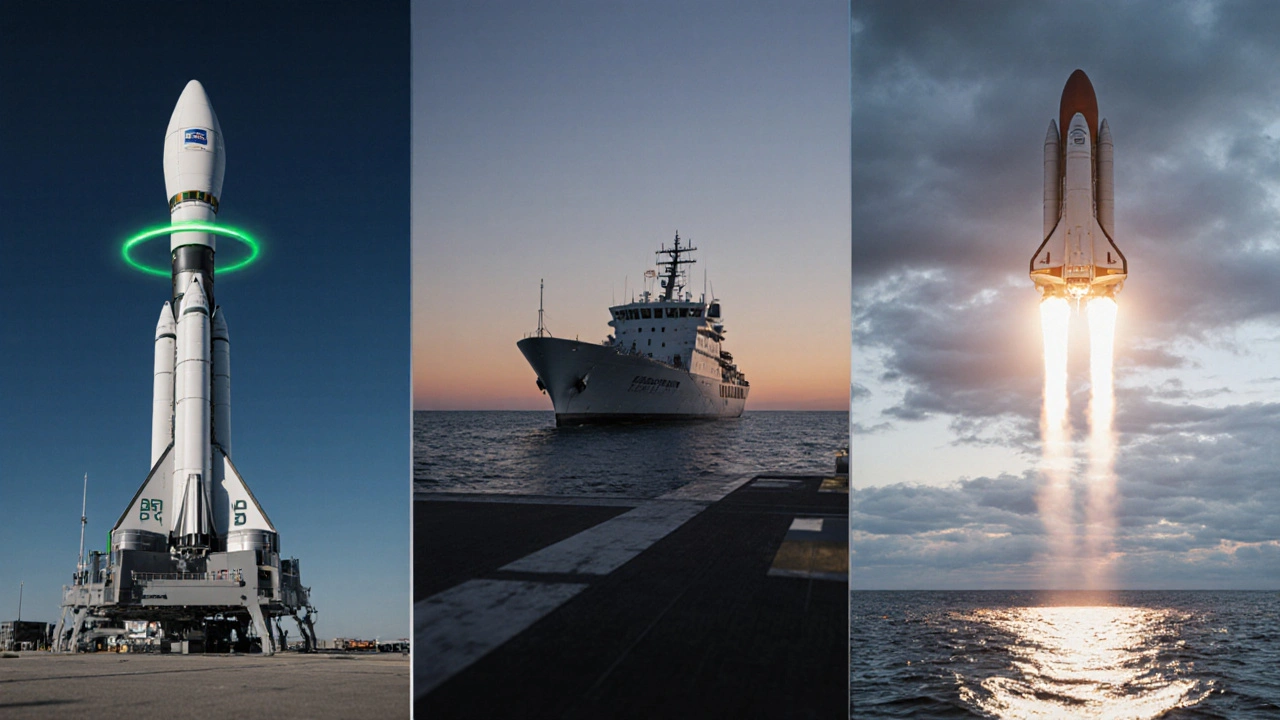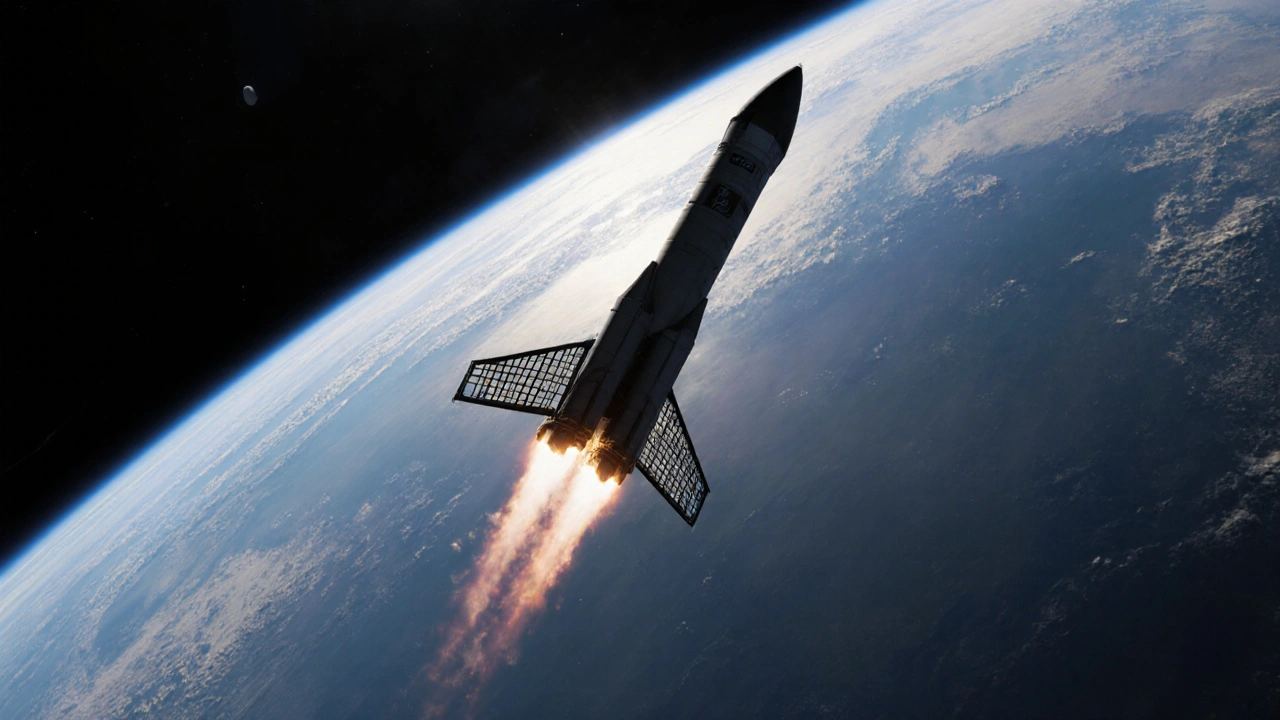Key Takeaways
- Falcon 9 boosters land using a single Merlin engine, grid fins, and deployable legs.
- Four major phases: boostback burn, re‑entry, landing burn, and touchdown.
- Block 5 upgrades allow up to 15 flights with minimal refurbishment.
- Landing can occur on ground pads, autonomous drone ships, or (rarely) ocean splash‑downs.
- Reusability cuts launch cost from ~$9,000/kg to about $2,700/kg.
When you see a Falcon 9 booster is a first‑stage rocket that returns to Earth after delivering its payload, you’re looking at a complex choreography of thrust, aerodynamics, and smart software. The whole process-often called the Falcon 9 booster landing-has turned a once‑in‑a‑generation idea into an everyday routine for SpaceX.
Why Reuse Matters
Building a new booster costs roughly $30 million, but refurbishing a recovered one is under $300 k. That price drop lets SpaceX charge customers about $2,700 per kilogram to orbit, far cheaper than the $9,000‑plus price of traditional expendable rockets. The economic upside is the main driver, but the engineering story is equally fascinating.
Core Components That Make a Landing Possible
Merlin engine is a liquid‑oxygen/r RP‑1 engine that powers both ascent and the final landing burn. During descent it fires at a fraction of its maximum thrust, slowing the booster to a near‑zero vertical speed.
Grid fins are four titanium control surfaces that pop out at ~70 km altitude. They steer the booster by shifting the center of pressure, allowing precision turns even at supersonic speeds.
Landing legs are carbon‑fiber struts with aluminum honeycomb cores. They unfold at about 1,000 ft altitude, spreading to a 19‑meter base to keep the booster upright.
Autonomous drone ship is a floating platform (e.g., "Just Read the Instructions") equipped with GPS, thrusters, and a steel landing pad, used when a mission’s trajectory sends the booster too far downrange for a land‑based pad.
Block 5 represents the final, production‑ready variant of Falcon 9. Its upgrades-enhanced heat shield, stronger titanium grid fins, and more robust legs-let a single booster fly up to 15 times with only minor checks between flights.
Flight control system runs on redundant Linux‑based computers. It processes data from accelerometers, gyros, and GPS to constantly adjust thrust and fin angles, keeping the booster on target.
Landing Zone 1 is a concrete pad at Cape Canaveral used for most east‑coast recoveries. Its GPS‑guided beacon tells the booster exactly where to touchdown.

Step‑by‑Step: The Landing Sequence
- Stage separation (≈65-85 km altitude): The first stage shuts down and separates, beginning its return flight.
- Boostback burn: If the mission calls for a return to the launch site, the central Merlin fires for ~30 seconds, reversing the booster’s trajectory.
- Re‑entry and grid‑fin deployment: At ~70 km the grid fins unfold. They steer the vehicle through the thickening atmosphere, generating the famous “triple‑sonic boom”.
- Coasting phase (≈40-50 km): Engines coast off while drag slows the booster further.
- Landing burn (≈1 km altitude): The Merlin reignites for a short, high‑thrust pulse that reduces vertical speed to under 2 m/s.
- Leg deployment (≈100 m altitude): Hydraulic actuators swing the landing legs outward, locking into place.
- Touchdown: The booster gently settles on the pad or drone ship, usually within a 10‑meter radius of the target coordinate.
Ground Pads vs. Drone Ships: When and Why
Landing on a pad is cheaper and simpler but requires the booster to have enough propellant for the full boost‑back. High‑energy missions-like geostationary transfers-often lack that reserve, so SpaceX opts for a downrange drone ship instead.
| Aspect | Ground Pad (LZ‑1/2) | Drone Ship (ASDS) |
|---|---|---|
| Typical Missions | LEO, low‑energy payloads | High‑energy GTO, polar, or long‑range missions |
| Propellant Needed | Boostback + landing burn | Landing burn only |
| Success Rate (2023‑2024) | ≈95 % | ≈93 % |
| Recovery Logistics | Truck transport, quick turn‑around | Ship hoist, longer transit to port |
| Typical Accuracy | ±10 m (recently ±3 m) | ±15 m |

Economic Impact of Reusability
Each flight saves roughly $25‑$29 million compared with building a fresh booster. By October 2023 SpaceX logged 305 successful landings out of 330 attempts-a 92 % success rate. The market share jump to around 60 % of global commercial launches is largely credited to this cost advantage.
Analysts at Morgan Stanley forecast launch costs could dip below $1,500 per kilogram by 2025 if turnaround times shrink to under 24 hours and the flight‑life ceiling rises beyond the current 15‑flight limit.
Future Directions
SpaceX is already testing faster refurbishment pipelines, aiming for a same‑day turnaround for low‑stress flights. Upgrades under the “Block 5‑plus” banner promise stronger heat‑shield tiles and even more durable grid‑fin bearings, targeting a 20‑flight lifespan. The company’s Starship, still in development, will push reusability further by landing full‑mass vehicles both on land and at sea, potentially erasing the payload‑penalty entirely.
Quick FAQ
How many times can a Block 5 booster be reused?
SpaceX designs Block 5 for up to 15 flights with minimal refurbishment, though a few boosters have already hit 18‑plus flights thanks to careful handling.
What triggers the grid‑fin deployment?
Grid fins pop out around 70 km altitude when the booster re‑enters denser atmosphere, giving the flight computer enough aerodynamic force to start steering.
Why does the booster sometimes land on a drone ship instead of a pad?
High‑energy missions consume most of the propellant during ascent, leaving insufficient fuel for a boost‑back burn. The booster then performs a direct landing burn over the ocean onto an autonomous drone ship.
How accurate are the landings?
Modern Block 5 landings routinely hit within 10 meters of the target, and recent missions have achieved as tight as 3 meters thanks to refined flight software and better fin actuation.
What happens if a landing fails?
If the booster misses the pad or loses a leg, it usually tumbles and is deemed a loss. The payload’s mission typically continues because the satellite is already in orbit, so the failure mainly affects cost, not the launch outcome.
Understanding the tech behind the Falcon 9 booster landing reveals why reusability isn’t just a buzzword-it’s a backbone that reshapes launch economics and paves the way for even bolder spacecraft in the near future.


7 Responses
The journey of a Falcon 9 booster from separation to touchdown is a symphony of physics and engineering. Each phase, from boostback to landing, can be read as a meditation on humanity's desire to recycle. When the first stage ignites its Merlin engine for the boostback burn, it is essentially turning a massive rocket upside down in mid‑air. This reversal of momentum is not just a clever trick; it reflects a philosophical commitment to turning waste into value. The grid fins, emerging like metallic feathers at 70 km, steer the booster with a grace that rivals a hawk riding thermals. Their titanium construction endures both extreme heat and the thinness of near‑vacuum, a reminder that strength often comes from resilience. As the booster coasts deeper into the atmosphere, drag becomes a silent partner, slowing the vehicle as if nature itself is giving it a gentle hand. The landing burn, a brief but potent thrust from the same Merlin that lifted the payload, trims the descent speed to a whisper. It is fascinating to think that the same engine works both to escape Earth's gravity and to surrender to it. The deployment of the carbon‑fiber landing legs at roughly a thousand feet feels like the moment a bird extends its wings for a final perch. Their eight‑inch‑wide pads distribute the force of impact, turning a potentially violent crash into a controlled kiss with the ground. The autonomous drone ships, floating midway across the ocean, stand as modern lighthouses guiding these metal birds home. The precision required to land within a few meters of a target on a moving platform is a testament to the sophistication of the flight control software, which constantly juggles accelerometer, gyro, and GPS data. Block 5’s design philosophy, allowing up to fifteen flights with only minor checks, encapsulates an ethos of sustainability that echoes ancient practices of repair and reuse. Economically, each reuse saves tens of millions of dollars, reshaping the market dynamics of satellite deployment. In the grand narrative of space exploration, the Falcon 9 booster landing is not merely a technical feat but a cultural milestone, signaling that the future of spaceflight may be built on cycles rather than singular triumphs.
From a grammatical standpoint, the article correctly uses the past tense when describing the boostback and re‑entry phases, which helps maintain temporal consistency. The use of parallel structure in the list of components-Merlin engine, grid fins, landing legs-also improves readability. Overall, the piece balances technical depth with clear phrasing, making complex concepts accessible.
It is commendable that SpaceX continues to pursue reusability while the rest of the industry pretends to be surprised by basic physics. One might argue that the economics are as clear as day, yet the headlines still gush over each successful landing as if it were a miracle. The tone of the original write‑up suggests awe, but the data simply confirms what engineers have known for years.
SpaceX's boostback burn is essentially a controlled reversal of velocity.
Yo, the whole grid‑fin thing is pretty sick-those little wings actually steer the whole thing like a surfboard on a wave. It's wild how the booster can flip around and still line up with a tiny pad miles away. Props to the software team for making that ballet look easy. And hey, if we all shared that kind of teamwork, everyday tasks would be smoother too.
Sure, the legs unfold just in time, because timing is everything, right? Still, it's not like they could have any more drama than a circus act.
The successful recovery of a Falcon 9 booster exemplifies the spirit of human ingenuity and perseverance. By extending the operational lifespan of these stages, SpaceX not only reduces launch costs but also advances sustainable practices within the aerospace sector. The meticulous engineering of the Merlin engine, grid fins, and landing gear reflects a dedication to precision. Moreover, the statistical improvement in landing accuracy underscores the continuous refinement of guidance algorithms. In sum, this achievement heralds a new chapter in aerospace where reuse becomes the norm rather than the exception.